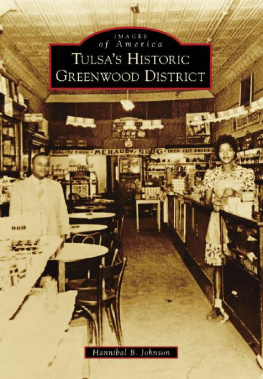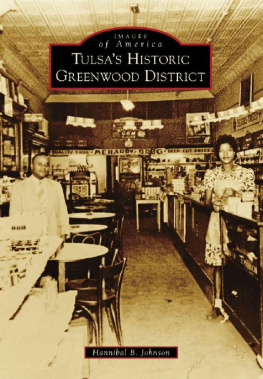IMAGES
of America
TULSAS HISTORIC
GREENWOOD DISTRICT
ON THE COVER: This c. 1940s photograph shows an unidentified store in the Greenwood District. Entrepreneurship flourished in the Greenwood District, with small shops and professional service providers leading the charge. (Courtesy of the Greenwood Cultural Center.)
IMAGES
of America
TULSAS HISTORIC
GREENWOOD DISTRICT
Hannibal B. Johnson

Copyright 2014 by Hannibal B. Johnson
ISBN 978-1-4671-1128-7
Ebook ISBN 9781439644560
Published by Arcadia Publishing
Charleston, South Carolina
Library of Congress Control Number: 2013942833
For all general information, please contact Arcadia Publishing:
Telephone 843-853-2070
Fax 843-853-0044
E-mail
For customer service and orders:
Toll-Free 1-888-313-2665
Visit us on the Internet at www.arcadiapublishing.com
This book is dedicated to the memory of Tulsas Greenwood District pioneers, whose vision, resourcefulness, and resilience earned them national renown. Their lives and their legacy will never be forgotten.
CONTENTS
ACKNOWLEDGMENTS
The author wishes to extend a special thanks to I. Marc Carlson, librarian of Special Collections and University Archives, University of Tulsa, for lending his considerable photographic and archival talents to this book. Thanks also to the following individuals and institutions: Beryl Ford Collection/Rotary Club of Tulsa; Tulsa City-County Library; Dana Birkes; Mechelle Brown, Frances Fleming, and Frances Jordan, Greenwood Cultural Center; Tom Gilbert, chief photographer, Tulsa World; Vanessa Adams-Harris; Wes Johnson; Jean Neal, John Hope Franklin Center for Reconciliation; Ian D. Swart, archivist and curator of collections, Tulsa Historical Society; Steve Wood; and Joe Worley, executive editor, Tulsa World.
INTRODUCTION
Tulsa, Oklahoma, The Oil Capital of the World, shone brightly at the dawn of the 20th century. Black gold oozed from Indian Territory soil, land once set aside for Native American resettlement. J. Paul Getty, Thomas Gilcrease, and Waite Phillips were among the men extracting fabulous fortunes from Oklahoma crude and living on Tulsa time.
As Tulsas wealth and stature grew, so, too, did its political, economic, and, in particular, race-based tensions. The formative years of this segregated city coincided with a period of marked violence against African Americans. In 1919 alone, more than two dozen race riots erupted in towns and cities throughout the country. That same year, vigilantes lynched at least 83 African Americans.
The Greenwood District in Tulsa blossomed even amidst this blacklash. African Americans engaged one another in commerce, creating a nationally renowned hotbed of black business and entrepreneurial activity known as Negro Wall Street. Greenwood Avenue, just north of the Frisco Railroad tracks, became the hub of Tulsas original African American community. Eclectic and electric, this artery drew favorable comparisons to legendary thoroughfares such as Beale Street in Memphis and State Street in Chicago.
This parallel black city existed just beyond downtown, separated physically from white Tulsa by the Frisco tracks and psychologically by layers of social stratification. In it, African American businesspersons and professionals mingled with day laborers, musicians, and maids. African American educators molded young minds. African American clergy nurtured spirits and soothed souls.
The success of the Greenwood District ran counter to the prevailing notion in that era of black inferiority. Fear and jealousy swelled over time. The economic prowess of Tulsas African American citizens, including home, business, and land ownership, caused increasing tension. Black World War I veterans, having tasted true freedom on foreign soil, came back to America with heightened expectations. Valor and sacrifice in battle had earned them the basic respect and human dignity so long denied at homeor so they thought. But America had not yet changed. Oklahoma had not changed. Tulsa had not changed.
A seemingly random encounter between two teenagers lit the fuse that set the Greenwood District alight. The alleged assault on a 17-year-old white girl, Sarah Page, by a 19-year-old black boy, Dick Rowland, in the elevator of a downtown building triggered unprecedented civil unrest. Deep social fissures, however, lay at the roots of the riot, which included white angst over African American prosperity, land lust, and a racially hostile climate in general.
A local newspaper stoked the embers of Tulsas emerging firestorm. The Tulsa Tribune framed the elevator incident in black and white: Nab Negro for Attacking Girl in an Elevator. Authorities arrested Rowland. A white mob vowed to lynch him.
A small group of African American men marched to the courthouse to protect Rowland. Upon their arrival, law enforcement authorities implored them to retreat, assuring them of the teens safety. They left, but the lynch talk persisted. Jarred by these persistent threats and increasingly concerned for Rowlands safety, more African American men assembled. Several dozen strong, these men, some bearing arms, trekked to the courthouse. There, they met and verbally engaged with the throngs of white men already massed. Two men struggled over a gun. The gun discharged. Chaos erupted.
Soon, thousands of weapon-wielding white men invaded the Greenwood District, seizing upon the Negro quarter with seismic fury. Some law enforcement officers stood idly by while others placed themselves squarely along the racial fault lines, even deputizing the white hoodlums who would set ablaze the area derogated as Little Africa. As flames raged and smoke billowed, roving gangs prevented firefighters from taking action.
In a 16-hour span, people, property, hopes, and dreams vanished. The Greenwood District lay in utter ruin. The State of Oklahoma declared martial law in Tulsa. The Oklahoma National Guard eventually restored order.
Authorities herded African American men into internment camps around the city, ostensibly for their own protection. Camp staff released detainees only upon presentation of green cards countersigned by white guarantors.
Property damage ran into the millions. Casualties numbered in the hundreds. Some African Americans fled Tulsa, never to return. Local courts failed to convict even a single white person of a crime associated with the riot. Prosecutors charged dozens of African American men with inciting it.
Even as the fires still smoldered, Greenwood District pioneers pledged to rebuild their community from the ashes. Official Tulsa leadership touted cooperation and collaboration, but hindered post-riot reconstruction. The Tulsa City Commission blamed African American citizens for their own plight. City officials turned away outside donations earmarked for the rebuilding. Attorney Buck Colbert Franklin rebuffed Tulsas attempt to enact a more stringent fire code that would have made post-riot rebuilding cost-prohibitive for many.
In the midst of the devastation, white allies surfaced. First Presbyterian Church and Holy Family Cathedral helped shelter and feed fleeing victims of the racial violence. The American Red Cross, heralded as Angels of Mercy, offered medical care, food, shelter, and clothing, and even established tent cities for the hordes left homeless by the riot.
African Americans shouldered their share of the load, too. Spears, Franklin & Chappelle litigated claims against the City of Tulsa and insurance companies and made urgent appeals to African Americans nationwide for assistance. Black builders secured lumber and supplies from surrounding states so reconstruction could commence. Entrepreneurs vowed to reestablish their businesses. Black churches rallied their parishioners. For Tulsas early African American denizens, the Greenwood District was much more than a business venue. It was home. Their determination and persistence ensured the survival of the community they knew and loved.
Next page


















